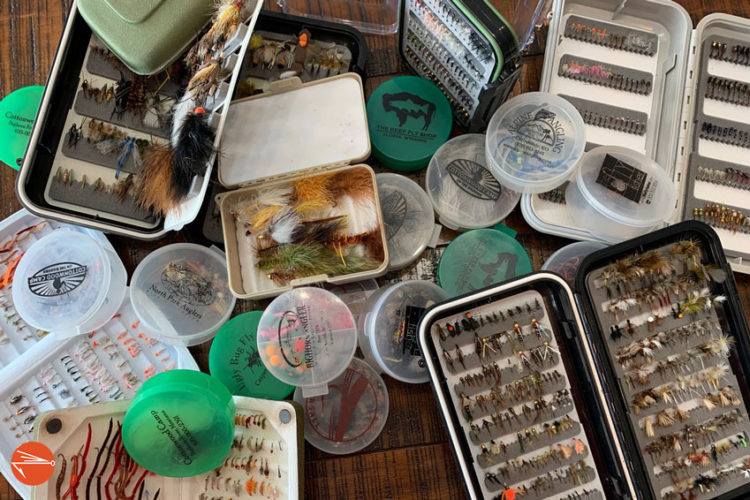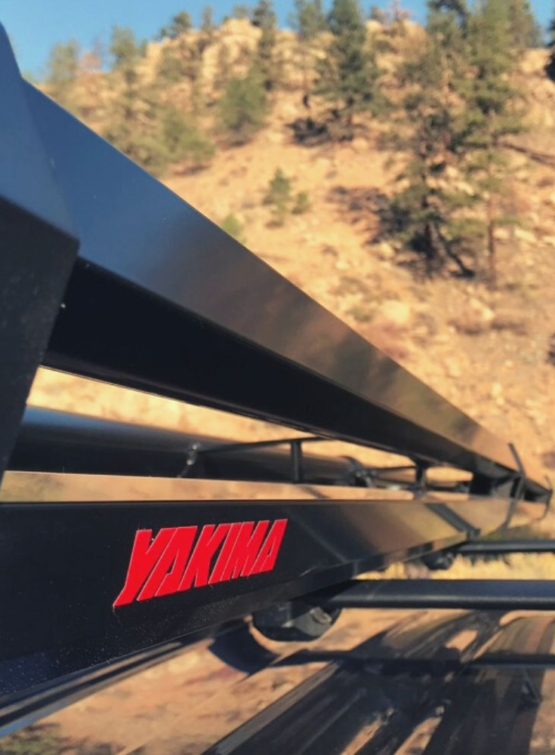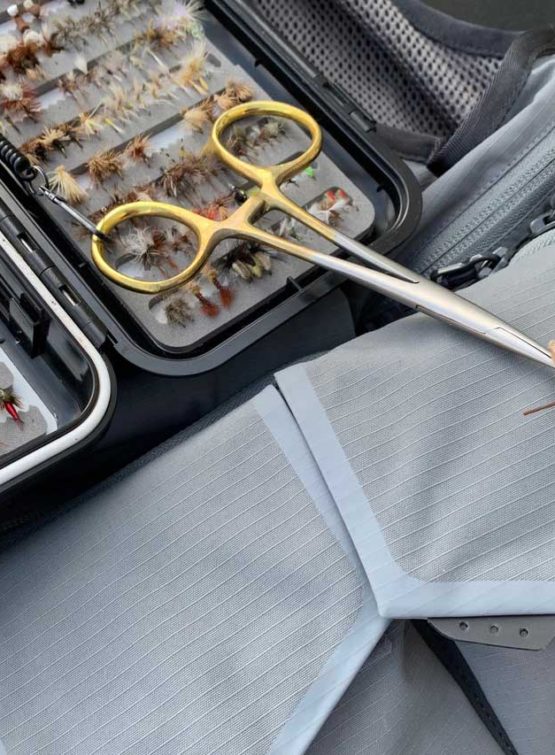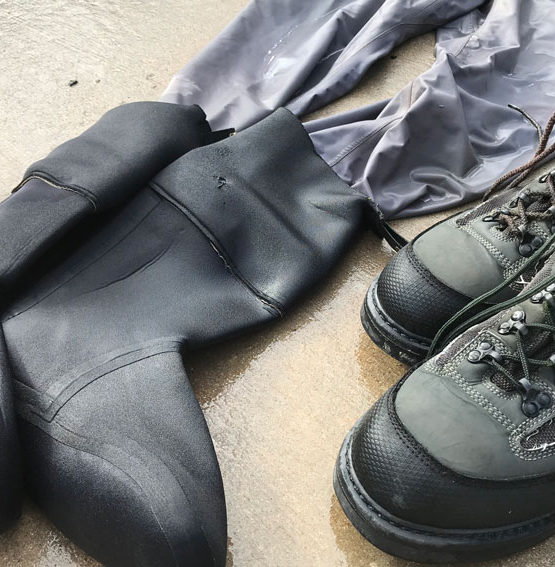If you’ve decided it’s time to buy a new fly box (or boxes) this year, read this first. In this post I reveal 7 key things to look for in a fly box.
About this time of year, I always engage in what some (my wife) might consider borderline ritualistic reorganization of my fly fishing gear. I don’t know where she gets this idea, I mean, other than the dark robe I wear, the candles I light, the Gregorian chant music I play and the backwards pair of underwear I wear on my head. But that’s beside the point.
This year, as I came to the part of my ritua… uh, process, involving fly rearranging, I realized that it was finally time to tackle a problem that had been growing, indeed metastasizing, for many years — my disjointed hodgepodge of terribly disorganized and annoyingly unruly fly boxes. In short, they had become just as crazily deformed as that last sentence, and, therefore, all needed to be replaced and all my flies reorganized.
Point of fact. I just got up from writing this article to actually count how many fly boxes I have. At the sudden realization that it would take too much effort, I immediately waved it off and sat back down at my keyboard. Suffice to say, I have a bunch of ‘em.
I’ve collected them over the years; one here, another there, and all with absolutely no plan, rhyme or reason. I have big ones, small ones, black ones, white ones, green ones, beige ones, see-through ones, opaque ones, waterproof ones, leaky ones, ones with magnetic latching, ones with regular latches, soft-sided ones, hard-sided ones, curved ones, flat ones, ones with logos, ones without, heck, I think I even have one with a Dora the Explorer sticker stuck to the inside cover. When it comes to what’s inside, and which of them to put in my vest for any particular day on the water, the phrase “confounding mess” doesn’t even begin to describe it.
One thing about having so many of them, on the other hand, is that, when it came time to replace and reorganize — and because most of the fly boxes I own feature one or two of the attributes I like, but none possessed them all — I knew exactly what I wanted. With that set of criteria fresh in mind, here are seven key things to look for when buying a new fly box.
Disclaimer: This post may contain affiliate links, meaning we will receive a small commission (at no cost to you) if you click through and make a purchase.1. Your Fly Boxes Should Be Durable
Fly boxes take a beating. I’ve sat on them, stepped on them, dropped them on rocks and into many rivers. I’ve thrown them into the back of pickups, wedged them under luggage, spilled drinks and food on them, smashed them with coolers and even melted one of them when I accidentally set it too close to a campfire.
As light as they can be, wimpy, soft-sided fly boxes just don’t hold up to sustained punishment. So, for my money, while I do appreciate lightness, I demand sturdiness and durability more.
Here’s an adage we’ve come to live by at Fly Fishing Fix: buy it nice or buy it twice. Keep this in mind when purchasing your next fly box.
2. Your Fly Boxes Should Have Thoughtful Design Features
I just watched the SpaceX rocket launch and found myself marveling at the amazingly well thought-out design of the rocket. From the stage-to-stage launch and orbit-establishing engineering, to the command module ergonomics and astronaut space suits, the design was not only incredibly intelligent, it was extremely efficient and cool! (Ya done good, there, Elon and team!)
Whether it’s a feat of aeronautical engineering on the order of the “SpaceX Dragon” rocket, the fascinatingly intelligent design of the human body, or something as mundane as a fly box, who doesn’t love design excellence?
When it comes to important features of a fly box, in addition to the ones I expound on in more detail herein, look for attributes that make your fly fishing day easier. Little things like rounded corners make it easier to pull your fly box out of, and shove it back into your vest or pack.
I like two-sided fly leaves with plenty of slots on both sides. I also look for boxes with removable leaves that you can replace with another one that you’ve populated with a different selection of flies. I appreciate trinkets like corner magnets on each leaf so that I don’t have to hold it down with my thumb when it’s windy.
I like plenty of interior clearance for flies with big hackles, as well as a solid and trustworthy closing clamp. Stuff like that is important to me, and it’s usually the little things that matter most.
3. Your Fly Boxes Should Come In Multiple Sizes And Colors
Since I’m reorganizing anyway, I’ve decided that I want all of my new fly boxes to be from the same manufacturer. Although I wanted them to come in different sizes for different fly types, I also wanted them all to have the same shape, design and color. I’d had it with the dizzying array of boxes in my possession.
Yes, generally speaking, I knew what fly grouping each of my differing boxes contained, but, as I’ve aged, the more I’ve had to open each one of them, before every trip, to remind myself of what’s inside. Maddening.
While you may take the advice above, you may choose to opt for different fly box colors to easily identify boxes with different fly groups. That’s up to you. In my case, once I get my new boxes arranged the way I want them, I’m planning to put some mileage on our label maker.
4. Your Fly Boxes Should Be See-Through
Speaking of label-makers, you may not need one if you buy see-through fly boxes. And assuming you now demand two-sided interior leaves, you’ll also want your fly boxes to be see-through on both sides.
Some perfectly good fly boxes come with fixed, two-sided interior fly-slot panels but, instead of one opening side, employ two independently opening covers on each side. We like this design as well, but this type of box tends to be a little thicker — a minor drawback.
5. Your Fly Box Should Have Plenty Of Fly Slots
A lot of decent fly boxes come with rows of foam ridges but no actual slots. These kinds of boxes have definitely served me well over the years, but when you’re repeatedly poking your flies into, and yanking them out of the foam, it tends to get pretty chewed up.
Because of that, I’ve gravitated toward fly boxes with pre-set slots. Not only do pre-slotted fly boxes better accommodate frequent fly-hook insertions and removals, they provide for a more uniform arrangement of your precious fly collection. And who wouldn’t want that?
6. Your Fly Boxes Should Feature Tight Slots
Let’s face it, the only place loose slots are desirable is in a casino.
In my soon-to-be replaced set of fly boxes, I own several with pre-slotted fly panels (good), however, most of them feature a foam material that doesn’t hold my flies tightly enough (bad). The result of loose fly slots? When you go to open your box, somehow, two or three of your good flies have come loose. If it’s a windy day, you can say goodbye to them.
Modern fly box construction employs better materials that hold your flies more firmly in position, thus, reducing annoyances like seeing one of your valued artificial flies take real flight out of your flawed fly box.
Apparently, since design responds to need, I’m not the only one who gives a dang about loose slots and wayward flies.
7. Your Fly Boxes Should Be Waterproof
Ever since I got my first Timex watch, I’ve heard the raging debate about whether something is truly waterproof or water-resistant. Frankly, some people have a tendency to get a little too militant about this mostly silly argument. To those folks, I say, Yes, okay, you’re right, no fly box can claim to be fully waterproof. Now, with that point duly conceded, when purchasing a new fly box, look for it to be waterproof. Waterproof when closed, that is, but I’m really hoping you had assumed that already.
Another thing I sincerely hope you’ve assumed is that fishing is an inherently wet undertaking. Not only are you typically standing in water, you will undoubtedly get rained on, splashed on, or take the occasional unintentional swim. If you’ve relegated your expensive collection of flies to a lousy fly box, they are going to get wet, even if the box is closed. And among the annoyances we mentioned before, opening your fly box to find that all of your little lovelies are wet and, in some cases, rusted, certainly makes it into the top five most vexing.
Another benefit of a waterproof fly box is that, again, when closed, it will float when you drop it into the drink. Read that sentence again. The key words are “float” and “when”, because it’s not if you drop your fly box, it’s when you drop your fly box, because you absolutely will. And when you do, you’ll certainly want it to be floating as you chase it down the river.
P.S. One of the other thoughtful design features of a good fly box is a place to connect a tether! Chasing things down a swift river is a great way to take that unintentional swim I mentioned. I’d recommend avoiding that possibility!
Related Content:
- Fly Fishing Without Waders: 6 Essential Tips
- What Is A Nymph Rig? And How To Set One Up
- 25 Best Dry Flies For Colorado Fly Fishing
- 12 Killer Foam Flies You Need To Try
- 15 Best Nymphs For Colorado (Here’s What You Need)
- 15 Best Flies For Cheesman Canyon
Boxing It All Up
Fly box selection is a more important aspect of fly fishing than many anglers realize. Considering all the clothing, equipment and gadgetry we must accumulate to optimize our chances of catching fish, fly boxes are often seen as one of those things we can get away with buying on the cheap.
Don’t do it. Spend the extra few bucks to land the better box. If you do so, it will serve you well for many years. It will also save you money and spare you a lot of aggravation over the long run.
Heed Ben Franklin’s words: “The bitterness of your poor quality fly box remains long after the sweetness of its low price is forgotten.”
Who knew ol’ Ben was a fly fisherman?
Tight Lines!










